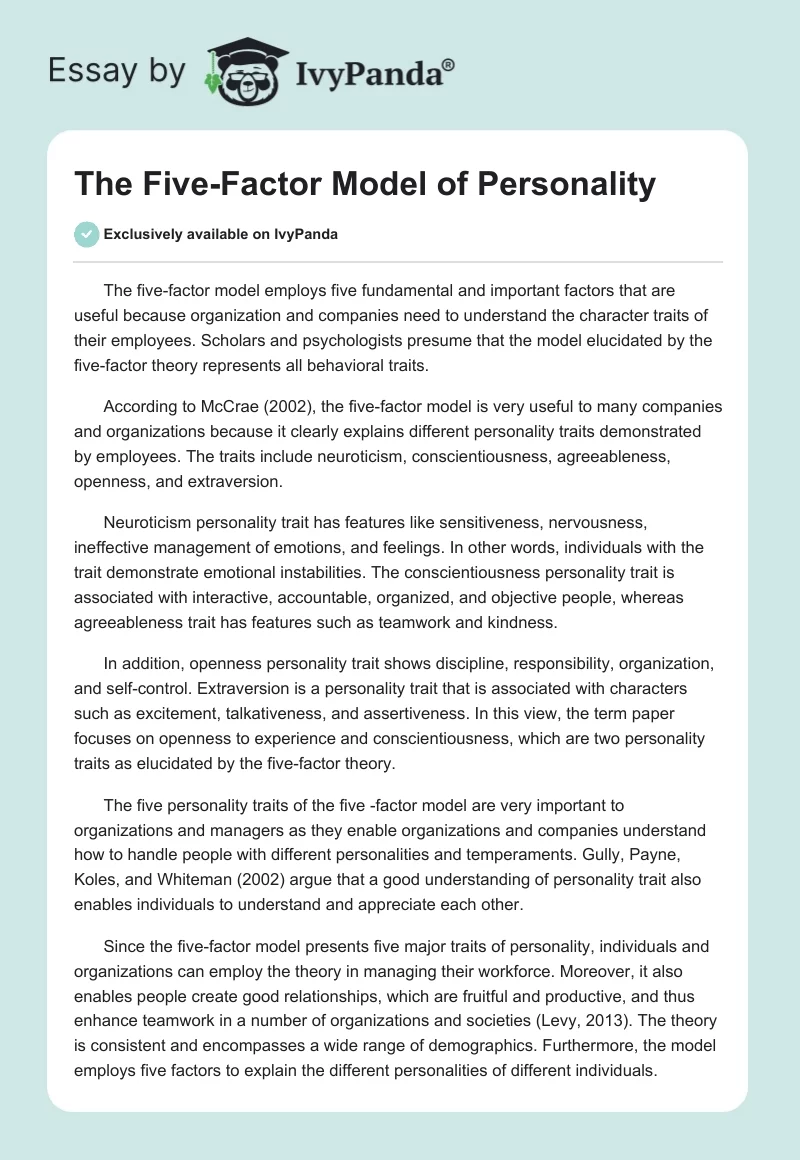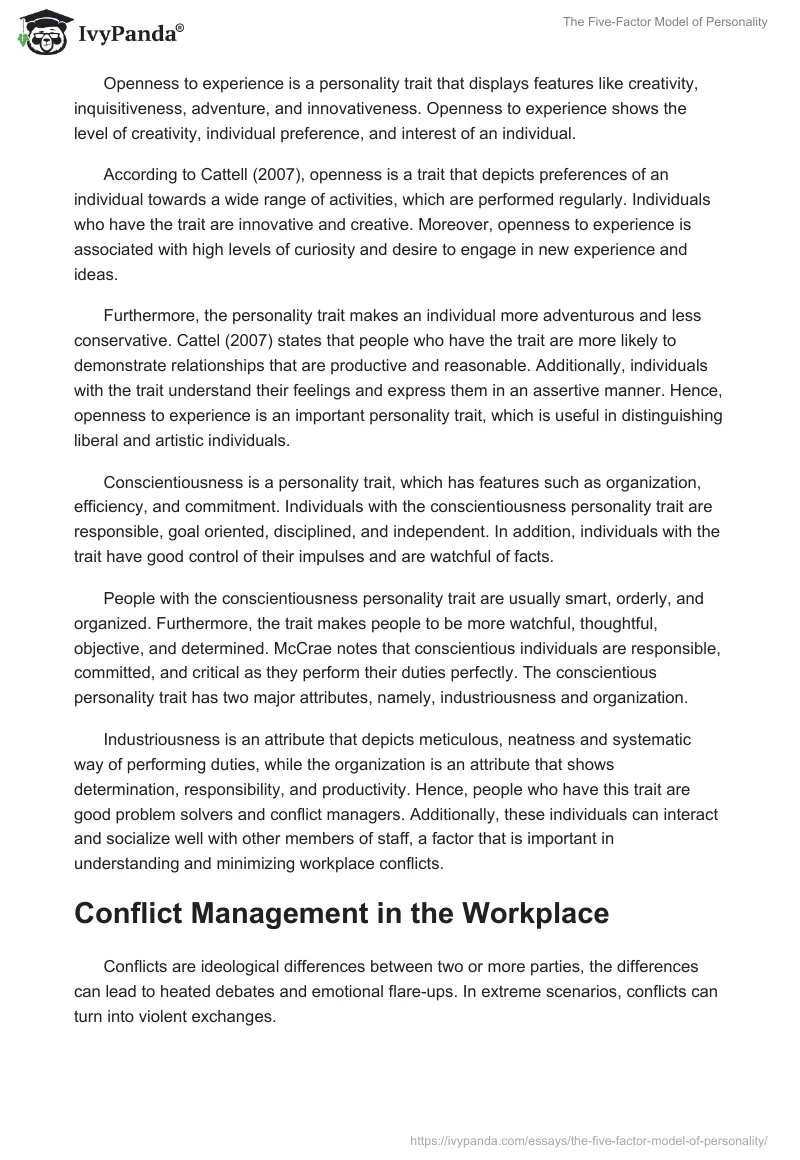The five-factor model employs five fundamental and important factors that are useful because organization and companies need to understand the character traits of their employees. Scholars and psychologists presume that the model elucidated by the five-factor theory represents all behavioral traits.
According to McCrae (2002), the five-factor model is very useful to many companies and organizations because it clearly explains different personality traits demonstrated by employees. The traits include neuroticism, conscientiousness, agreeableness, openness, and extraversion.
Neuroticism personality trait has features like sensitiveness, nervousness, ineffective management of emotions, and feelings. In other words, individuals with the trait demonstrate emotional instabilities. The conscientiousness personality trait is associated with interactive, accountable, organized, and objective people, whereas agreeableness trait has features such as teamwork and kindness.
In addition, openness personality trait shows discipline, responsibility, organization, and self-control. Extraversion is a personality trait that is associated with characters such as excitement, talkativeness, and assertiveness. In this view, the term paper focuses on openness to experience and conscientiousness, which are two personality traits as elucidated by the five-factor theory.
The five personality traits of the five -factor model are very important to organizations and managers as they enable organizations and companies understand how to handle people with different personalities and temperaments. Gully, Payne, Koles, and Whiteman (2002) argue that a good understanding of personality trait also enables individuals to understand and appreciate each other.
Since the five-factor model presents five major traits of personality, individuals and organizations can employ the theory in managing their workforce. Moreover, it also enables people create good relationships, which are fruitful and productive, and thus enhance teamwork in a number of organizations and societies (Levy, 2013). The theory is consistent and encompasses a wide range of demographics. Furthermore, the model employs five factors to explain the different personalities of different individuals.
Openness to experience is a personality trait that displays features like creativity, inquisitiveness, adventure, and innovativeness. Openness to experience shows the level of creativity, individual preference, and interest of an individual.
According to Cattell (2007), openness is a trait that depicts preferences of an individual towards a wide range of activities, which are performed regularly. Individuals who have the trait are innovative and creative. Moreover, openness to experience is associated with high levels of curiosity and desire to engage in new experience and ideas.
Furthermore, the personality trait makes an individual more adventurous and less conservative. Cattel (2007) states that people who have the trait are more likely to demonstrate relationships that are productive and reasonable. Additionally, individuals with the trait understand their feelings and express them in an assertive manner. Hence, openness to experience is an important personality trait, which is useful in distinguishing liberal and artistic individuals.
Conscientiousness is a personality trait, which has features such as organization, efficiency, and commitment. Individuals with the conscientiousness personality trait are responsible, goal oriented, disciplined, and independent. In addition, individuals with the trait have good control of their impulses and are watchful of facts.
People with the conscientiousness personality trait are usually smart, orderly, and organized. Furthermore, the trait makes people to be more watchful, thoughtful, objective, and determined. McCrae notes that conscientious individuals are responsible, committed, and critical as they perform their duties perfectly. The conscientious personality trait has two major attributes, namely, industriousness and organization.
Industriousness is an attribute that depicts meticulous, neatness and systematic way of performing duties, while the organization is an attribute that shows determination, responsibility, and productivity. Hence, people who have this trait are good problem solvers and conflict managers. Additionally, these individuals can interact and socialize well with other members of staff, a factor that is important in understanding and minimizing workplace conflicts.
Conflict Management in the Workplace
Conflicts are ideological differences between two or more parties, the differences can lead to heated debates and emotional flare-ups. In extreme scenarios, conflicts can turn into violent exchanges.
Conversely, when controlled and managed effectively, conflicts produce positive results that help the company grow and attain its objectives (Rahim, 2002). Negative consequences of conflicts take place when there are no control measures to solve or manage the disagreements in their early stages. Usually, conflicts spiral out of control and even result in riots.
Conflicts are common in every organization because individuals working in companies have different personalities, thinking capacities, and behaviors. Levy (2013) argues that conflicts take place when the individuals differ in terms of opinions, ideas, and points of view. In addition, conflicts take place when an individual or a party is not willing to compromise and reason from the perspective of the other party.
While working as a hotel supervisor, I witnessed a number of conflicts between the junior staff and senior staff, executive and staff, or between clients and employees. The conflicts started because of misunderstandings, poor service delivery, and failure to reach compromise on matters that relate to unfair promotions.
According to Keith and Frese (2005), conflicts in the workplace are common, and thus organizations should formulate effective measures to reduce the negative effects occasioned by conflicts. The conflicts greatly affected the performance of the organization. Consumers received poor services, as many employees were in conflict with one another.
In addition, the chain of communication was hierarchal and bureaucratic; hence, junior and senior staff could not present their grievances or complaints on time. Therefore, the firm could not effectively manage the difference of ideas and points of view among the members of staff on time. Furthermore, conflict management strategies were not efficient, as many members of staff did not get enough time to know and understand the characters of other employees in the firm as they had busy schedules.
Additionally, teamwork, which is one of the important components of a successful organization, was no longer practical as many employees, management team, and the executives had frequent conflicts and disagreements. Therefore, many staff members preferred doing duties according to their own will and interests. The result was reduced productivity, poor product quality, dissatisfied clients, and frequent strikes.
Poor working relationship among members of staff created a hostile environment for the employees, management team, and clients, which affected organizational performance. Keith and Frese (2005) argue that substantial conflicts transpire when group members disagree over a task or on how to perform the task.
Therefore, the organization was experiencing substantial challenges such as intra-organizational and interpersonal conflicts as the members of staff disagreed over crucial issues that are central to organizational performance.
Most members of staff were not willing to compromise with their colleagues so that they would arrive at workable solutions to challenges in the workplace. The unwillingness attitude further complicated the magnitude of conflicts among employees, management team, and clients, and thus hampered organizational performance. There was a need for the firm to devise strategies that would help in the resolution of conflicts.
According to Rahim (2002), “conflict management minimizes the negative outcomes of conflicts and promotes the positive outcomes of conflict with the goal of improving learning in an organization” (p. 208). Hence, the firm had to quickly employ conflict management skills and provide realistic and workable solutions to the conflicts. This would not only help the management in improving the firm’s performance, but also enhance working relationships among the members of staff.
Relevance of the Five-Factor Model Theory in Conflict Management
The five-factor model theory is very instrumental in providing solutions towards conflict management, which is the existing situation in the firm. The organization can use qualities of openness to new experiences and conscientiousness personality traits from the five-factor model theory to manage and resolve existing conflicts. Furthermore, the organization can instill features such as openness and encourage their employees to be assertive so that they can express their feelings without hurting others and without fear (Cattel, 2007).
This will enable the human resources of the firm to present their views and opinions assertively without hurting other members of staff. Additionally, the five-factor theory of personality will help the organization and its employees understand different behaviors of individuals and the different ways of handling each personality.
Therefore, an understanding of the personality traits is paramount in an organization because it helps in shaping organizational behavior. The understanding of personality enables human resource managers to hire individuals who are suitable for a given job. Furthermore, employers can also place people in various job positions basing on their traits, and thus become relevant as they can turn ideological differences into productive conflicts.
In addition, Rahim (2002) states that conscientiousness and openness will help an organization and the members of staff to control their emotions, mind about others, attain smartness, and become responsible. These factors are very vital in ensuring that an organization achieves its targets. Furthermore, the individuals will work in creative a manner by turning conflicts into avenues for organizational growth.
References
Cattel, H. (2007). Personality Theory and Testing. London: Sage.
Gully, S. M., Payne, S. C., Koles, K., & Whiteman, J. A. K. (2002).The impact of error training and individual differences on training outcomes: An attribute-treatment interaction perspective. Journal of Applied Psychology, 87(1), 143.
Keith, N., & Frese, M. (2005).Self-regulation in error management training: emotion control and meta-cognition as mediators of performance effects. Journal of Applied Psychology, 90(4), 677-685.
Levy, P. (2013). Industrial Organizational Psychology: Understanding the Workplace. New York: Worth Publishers.
McCrae, R. (2002). An Introduction to Five Factor Model and its Applications. Journal of Personality, 60(2), 175-215.
Rahim, M. (2002). Towards a Theory of Managing Orgsanizational Conflict. The International Journal of Conflict Management,44(5), 206-235.


